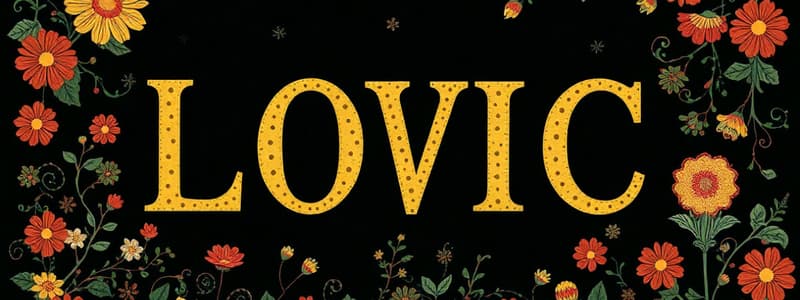Podcast
Questions and Answers
Which of the following word components is characterized by a single sound despite being represented by two letters?
Which of the following word components is characterized by a single sound despite being represented by two letters?
- Consonant
- Vowel
- Blend
- Digraph (correct)
In the word 'cats,' the 's' is an example of what grammatical element?
In the word 'cats,' the 's' is an example of what grammatical element?
- Possessive
- Suffix (correct)
- Pronoun
- Contraction
Which of these grammatical functions is primarily indicated by the apostrophe?
Which of these grammatical functions is primarily indicated by the apostrophe?
- Plural nouns
- Verb conjugation
- Possessives and contractions (correct)
- Adjective agreement
Identify the word from the options below that functions as a pronoun.
Identify the word from the options below that functions as a pronoun.
Which of the following best describes the key difference between a blend and a digraph in phonics?
Which of the following best describes the key difference between a blend and a digraph in phonics?
Flashcards
Blends
Blends
Groups of letters that sound like a single letter when spoken.
Vowels
Vowels
Letters that represent one sound when spoken.
Consonants
Consonants
Letters that are not vowels and typically represent single sounds.
Suffixes
Suffixes
Signup and view all the flashcards
Possessives
Possessives
Signup and view all the flashcards
Study Notes
Digraphs
- Digraphs are two letters that represent one sound.
- Examples include: "sh," "ch," "th," "ph," "wh."
- They are frequently used in English to create specific sounds not represented by single letters.
Blends
- Blends are combinations of consonant sounds, where each consonant sound is made.
- These sounds are distinct and can be broken down.
- Examples include: "st," "bl," "gr," "sk."
Vowels
- Vowels are the sounds that are made with an open throat.
- They form the core of syllables in words.
- English has five (or sometimes six, when considering "y") basic vowel sounds, typically represented by the letters a, e, i, o, u and sometimes y
- Different letters can represent the same vowel sound, like "a" in "father," "air," and "cat".
- The pronunciation of vowels can change based on surrounding letters and stress in the word.
Consonants
- Consonants represent a broader range of sounds characterized by a constriction of the speech organs.
- They often accompany vowels in forming syllables.
- Consonant sounds vary in manner and place of articulation, and voicing.
- Examples include: p, b, t, d, k, g, f, v, etc.
Suffixes
- Suffixes are added to the end of a word to modify its meaning or part of speech.
- Examples include "-ed" (past tense), "-ing" (present participle), "-s" (plural noun).
- They affect the tense, number or other grammatical aspects of a word.
- They may change the intended meaning, or the function of a given word.
Possessives
- Possessives show ownership or belonging.
- They are typically formed using an apostrophe and "s" ('s).
- Plural possessives use only the apostrophe after the "s" (e.g., the girls' toys).
- Some nouns have irregular forms (e.g., the child's toy, the men's clothes).
Noun
- A noun is a word that names a person, place, thing, or idea.
- Common nouns refer to general categories (e.g., dog, house, love).
- Proper nouns refer to specific people, places, or things (e.g., Fido, White House, Democracy).
- Nouns can be modified by adjectives.
Pronoun
- Pronouns replace nouns to avoid repetition.
- They represent a person, place, or thing.
- Examples: I, you, he, she, it, we, they, me, him, her, us, them.
Contractions
- Contractions are shortened forms of words, typically combining a verb and a pronoun (or other words).
- The most common type uses an apostrophe to show where letters have been omitted.
- Examples: can't, won't, I'm, you're.
Apostrophe
- The apostrophe (') is used in English.
- Frequently used in contractions and possessives.
- It shows where letters or syllables are removed.
- It indicates ownership, or shows how two words have been merged into a shorter form.
Studying That Suits You
Use AI to generate personalized quizzes and flashcards to suit your learning preferences.




